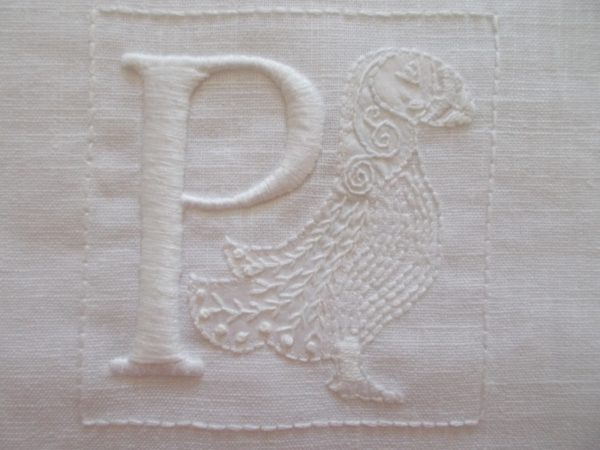
Whitework P for puffin (hand embroidered by Mary Addison)
It just had to be P for Puffin as, in so many ways a puffin is not quite what it seems. One evening, I was roused from semi sleepily watching old episodes of QI on Dave by the Quite Interesting fact that puffins only look like picture book puffins with those glorious striated orange bill plates and ornamented eyes for about four months a year during the breeding season! In fact they spend the lion’s share of the year with smaller, much duller and less beaky beaks. Now, how have I not picked this up in my passage through life? Worse was to come when I looked into the bird further, for Puffinus puffinus is the scientific name, not for the puffin but for the Manx shearwater, a much less attractive bird, whose form I know well as we once housed quite a large painting of said bird for some months while an art dealer friend decided what to do with it. (The art dealer may have hoped my first husband, an enthusiastic bird watcher, would buy it but a painting of a large dark bird flying over a stormy sea to a background of ragged cliffs wasn’t quite what I wanted to spend my leisure time looking at, so eventually the dealer took it away.)
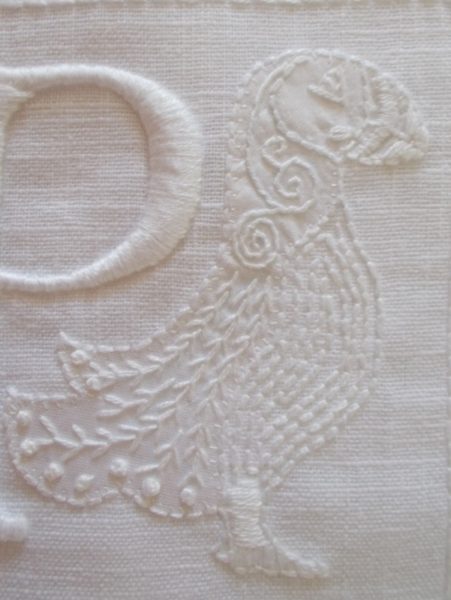
Detail: whitework P for puffin (hand embroidered by Mary Addison)
In Middle English pophyn or poffin, means swollen, but this referred not to a quality of the live Manx Shearwater but rather to the cured carcasses of the birds whose salty meat was puffed up with fat and highly valued! Thus the Manx Shearwater became known familiarly as Manx Puffin. Meanwhile, the Atlantic puffin (the one of the 3 species we in the UK are most familiar with) acquired the name Puffin probably because of similar nesting habits and possibly because, once its flamboyant beak was shed it looked less distinctive and a little bit like the Manx shearwater. Ummm all a bit confusing , so to get this clear:
Puffinus puffin = Manx shearwater
Fratercula artica = Arctic puffin
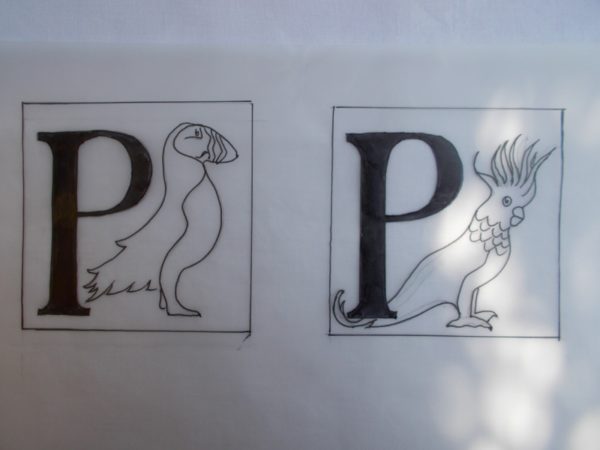
sketches for P for Puffin or P for parakeet
When my two elder children were little and we were staying in Pembrokeshire along with my parents we took a trip out to Skomer Island, known for its puffins (and also I learn only now that it’s an important nesting ground for about half of the world’s Manx Shearwaters). It must have been breeding season for the puffins had their best beaks on but I most remember it for not being the best place to take an elderly relative with troublesome feet. The climb from the boat was stepped, quite steep and dramatic for those not happy with heights and although once on the top it was an easy walk on flat land, there were so many puffin nesting holes you had to keep your wits about you to not accidentally stray off the path and turn your ankle in a puffin hole. The 3 and 4 year olds had a lovely time with so many colourful birds to spot, though whether the birds enjoyed it as much I wouldn’t like to say.
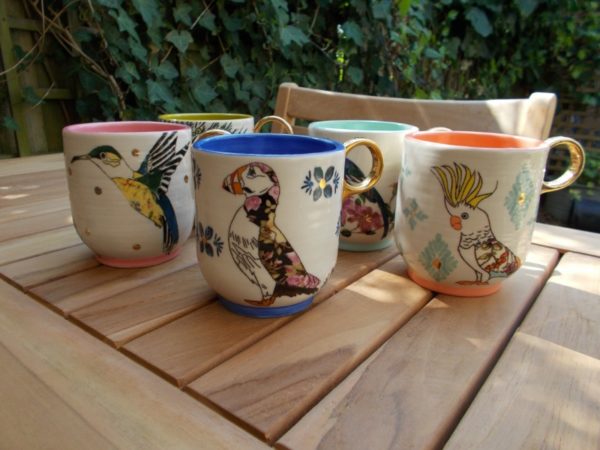
Anthropologie mugs that inspired P for puffin and P for parakeet
But to get back to those beaks. As well as being seasonally flamboyant, internally they are also pretty special, with teeth like spines called denticles facing backwards towards the throat which spear and hold fish pushed over them by the tongue so that more fish can be caught and carried securely in one foraging outing (the average is 10, but as many as 126 have been recorded). For more interesting puffin facts see Planet Puffin. Charmingly a baby puffin is a puffling.
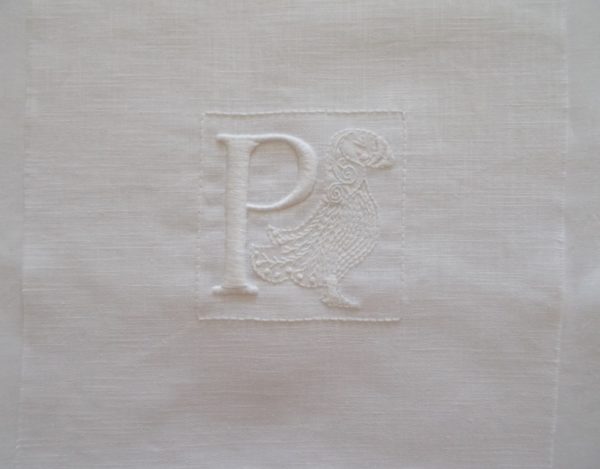
Whitework P for Puffin (hand embroidered by Mary Addison)
Not having got hold of a copy of Hilary Mantel’s The Mirror and the Light, the third and final book about Thomas Cromwell, I have been listening to it on iPlayer. Admittedly, it’s an abbreviated version but it won’t stop me enjoying the real thing later – I mean we all know it won’t end well for Cromwell. And once more, Hilary Mantel is wonderful on the clothing which becomes the silent bearer of another level of text and far beyond mere the frippery of who’s wearing what. I can’t resist quoting a couple of passages that caught my ear.
The new queen Jane Seymour is sewing with her ladies.
“The ladies are settling to the tasks which have absorbed them for weeks, erasing the initial A from satin and damasks and replacing it with Jane’s initial so she can wear the clothes of the late queen. “I remember sewing this one in,” Bess’s tone is low and absorbed, seed pearls showering from her scissors. Jane is working on a private piece of sewing. Perhaps it is unbecoming of a queen to snip away at her predecessor.”
(Ouch, never has ‘snip’ been so sharp.)
Henry and Anne of Cleve’s marriage:
“The king himself on a great courser in purple and cloth of gold, his garments sashed and puffed, slashed and swagged and so studded and slung with belts of gemstones he seems to be wearing a suit of armour forged and welded for Zeus. The bride Anna glitters as they enthrone her on her mount. “
(All those adjectives for Henry’s clothes and just the one to describe Anne!)
Have a good Easter.

10 Comments
Desperate for a change of pace from baby books, today I tried something new – and am happy to report that baby Georgia quite enjoyed a dramatic reading of your puffin facts and Mantel quotes this morning. Thank you for helping start her on a path of enjoying handwork, nature and good books! (Eight weeks down, many more to go…) Have a happy Easter!
Well thank you Austen for letting me know baby Georgia enjoyed your rendition of my blog.
I seem to remember poetry with a good dumpty dumpty rhythm being useful – even a nice bit of Dante in Italian from time to time as the terza rima has a lovely flow even if you don’t understand everything. Longfellow’s Hiawatha is also fun to read out loud to your baby too.
Enjoy Georgia as much as you can, time goes very quickly – my oldest is 40 today.
Well, I never knew that about Manx Shearwaters, either! Thank you!
All part of the joy of living!
Puffling! Such a sweet name
Isn’t it. Stephen Fry went quite soppy over it on QI too.
Could it be used to describe a young reader (of Puffin books)?
Why not, Nella – or we could even use it to describe an older reader of a Puffin book as we tend to be the ones with libraries full of Puffin books.
Just charming. We have a flock of white pelicans in our nearby wetlands, and I just found out that the horn on the top of their beaks is only present during mating season. These birds never finish surprising me.
Well I never knew that either – but then again the only pelicans I’ve ever seen are those in London Zoo.